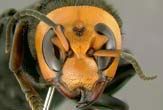
E: Environment, Enrichment,
Education, & Endangered Species
All content © by Diana L. Guerrero unless otherwise noted and may not be reprinted without prior written permission. All rights reserved. Click here for reprint permissions and fees.
New species were recently discovered in a biodiversity hotspot in Tibet. The discovery of these animal_s_ of the month were officially announced in April of 2006. To your left is the Giant Asian Hornet (Vespa mandarinia), which local villages have named the ‘Yak Killer’ for its deadly sting.
Animals of the Month: New Species
Discovered in a Himalaya Hideout
Despite rugged terrain and frigid temperatures new discoveries by a team of international scientists documented new, rare and endangered species in Tibet.
Dr. Leeanne Alonso, the lead scientist of the expedition and vice-president of Conservation InternationaI’s Rapid Assessment Program (RAP) said, “Local efforts by Tibetan communities through their ‘Sacred Lands’ are helping to prevent these plants and animals from going extinct and demonstrate that cultural values can play an important role in conservation.” Highlights of the new species discovered by the team of biologists, botanists and other technical experts include:
- A wingless grasshopper (Kingdonella) that can withstand extremely low temperatures and communicates by ‘gnashing’ its teeth. The male in this group rides on the back of the female for quite a long time, often days, to prevent other males from mating with her.
- The confirmation of a new beetle species (Nicrophorus schawalleri) that specializes in burying small bird and rodent carcasses into a subterranean crypt to feed their offspring.
- A new subspecies of a small mammal known as the Qinghai vole (Microtus fuscus), whichh was also a new record for the Sichuan province.
- Up to three new species of frogs, eight new species of insects, and ten new species of aants
- Several potentially new species of plants.
Among the highlights of the rare and endangered species the team came across are the endangered Sichuan jumping mouse (Eozapus setchuanus); a katydid (Tettigonia chinensis) which has been seen only once since it was described in 1933; and two ancient plant species, including one that is an important source for cancer drugs (Taxus wallichiana). The team also dodged the Giant Asian Hornet (Vespa mandarinia), which local villages have named the ‘Yak Killer’ for its deadly sting.
A select team from the mission also had the thrill of observing the world's only fully habituated troop of golden monkeys (Rhinopithecus roxellana), the region's flagship species second only to the giant panda. The full results from the expedition will be shared with numerous entities, such as the Chinese government, environmental organizations and scientists to develop conservation strategies to protect the unique species of the region.
During the two-month expedition, the team explored six different sites in the Mountains of Southwest China and Himalaya Biodiversity Hotspots. The biodiversity hotspots are part of 34 regions worldwide where 75 percent of the planet’s most-threatened mammals, birds, and amphibians survive within habitat covering just 2.3 percent of the Earth’s surface. An amazing 50 percent of the Earth’s vascular plants and 42 percent of terrestrial vertebrates exist only in these 34 hotspots. Hotspots face extreme threats and have already lost at least 70 percent of their original vegetation.
“Being part of the Mission Himalayas team has given us all a renewed sense of hope for conservation efforts in this region of the world,” said expedition scientific team member Dr. Anne Savage, senior conservation biologist at Disney’s Animal Kingdom. “Having seen how the sacred lands project has integrated cultural needs and conservation priorities, resulting in the discovery of new species, and having the opportunity to see how golden monkeys–which were severely threatened by poaching and habitat destruction–are now thriving, it is clear that local communities, conservation organizations, and governmental agencies can work together to effect change and insure the survival of species and habitat...”
The Himalayas face great challenges from rapid social and economic development. In the Mountains of Southwest China, a growing population of immigrants from other parts of the country is shifting the balance of Tibetan influence. Road construction, which is causing habitat loss, also is bringing more tourists to the area, which in turn has created a market for wildlife products.
Other partners in the project include Disney and Discovery along with local partners including the Sichuan Academy of Forestry, Chengdu Institute of Biology, Sichuan Regional Forestry Department, and The Mountain Institute in Nepal.
Funding for the expedition was generously provided by Disney Wildlife Conservation Fund (DWCF) and the Walt Disney Company. The Mission Himalayas expedition builds upon a decade-long relationship between CI and Disney to support biodiversity conservation.
During their affiliation, DWCF and the Walt Disney Company Foundation have contributed to several CI initiatives including a Global Amphibian Assessment, the protection of Cambodia’s Cardamom Mountains, and a conservation project in Botswana. Additionally, Russell A. Mittermeier, Ph.D., president of CI, is a member of Disney’s Animal Kingdom Advisory Board. CI’s contributions to Disney’s Animal Kingdom have been fundamental to the values of the park.
About the columnist: Since 1978 Diana L. Guerrero has worked professionally with both wild and domestic animals. Guerrero has been affiliated with, and certified by, a variety of animal programs in the USA and Europe. Based in California, she writes, consults, and speaks. Information on her animal career programs, training courses, and her books {What Animals Can Teach Us about Spirituality (SkyLight Paths, 2003), Blessing of the Animals (Sterling, 2007), Help! My Pet is Driving Me Crazy (Guerrero Ink, 2007), Animal Disaster Preparedness for Pet Owners & Pet Professionals (Guerrero Ink, 2007)} can be found in this web site and in the shop. Questions for Guerrero should be submitted via the blog comments or membership forum.





